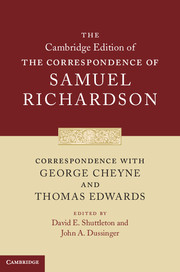V - Names of Those Readers to be Permitted to Read the Richardson–Edwards Correspondence
Published online by Cambridge University Press: 30 June 2022
Summary
The names of these ‘excellent Persons’ are specified thus: Arthur Onslow, Speaker of the House of Commons, his son George, Dr William Heberden the elder (Richardson's physician, whom Samuel Johnson revered as ‘ultimum Romanorum, the last of our learned physicians’), Joseph Paice and Nathaniel Mason (Edwards's two nephews and sole heirs), and two women in the select circle, Hester Mulso andMrs Ann Donnellan. Mulso, poet and essayist, was a frequent guest at North End, and in 1760 she married a lawyer, John Chapone, son of the author Sarah Chapone. A contributor of the four billets to Rambler, no. 10, Mulso published anonymously in 1773 the Letters on the Improvement of the Mind, which was dedicated to Elizabeth Montagu. Mrs Ann Donnellan was not married but as a middle-aged, accomplished woman received this designation; she was the daughter of Nehemiah Donnellan, who had been Lord Chief Baron of the Exchequer in Ireland. Ann's sister was thewife of the Bishop ofKillala andAchonry. Both sisters were friends of Jonathan Swift, who calledMrs Donnellan ‘the syren’ because of her singing talent. Her interest in music brought her into acquaintance with Georg Frederick Handel, and Richardson may have met the composer at her home.
- Type
- Chapter
- Information
- Publisher: Cambridge University PressPrint publication year: 2013



